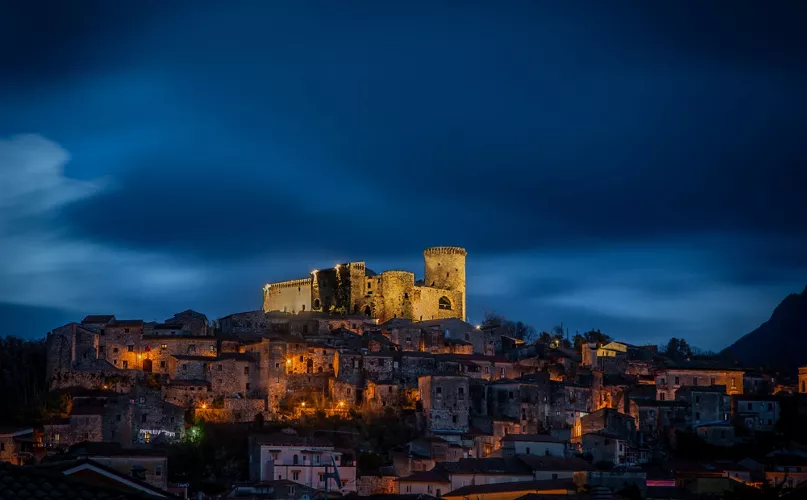
Overview
Riardo Castle and its bubbling springs
One of the most enchanting villages in the Upper Caserta area and a landmark on the route known as the Southern Way of St Francis, Riardois a small mountain town on the northern slope of theTrebulani Mountains, dominated by an imposing Longobard castle. The village has been associated with water since ancient times, and this alone makes it worth seeing. Riardo was already famed in Roman times for its naturally effervescent springs, which are also mentioned by Vitruvius and Pliny the Elder.
Panoramic view from the castle window
The main attraction and extraordinarily panoramic viewpoint of the town, Riardo Castle stands on the hill overlooking the plain of the Savone river, which rises from the extinct volcano of Roccamonfina. During restoration work, a stone bearing the date 1122 was found near the entrance, but the castle's origins most probably stretch back even further than that, to the 9th century, when the Longobard Castaldei dynasty chose this spot to build one of the many defensive fortresses in the county of Capua. The building was then expanded two centuries later, in the Norman era.
The most striking architectural feature and the crowning glory of this castle is the huge arched window, through which you can admire the breathtaking view of the plain below, stretching out as far as the sea: don't miss it!
Another unusual detail is the master tower, which has hollow walls within which the steps up to the keep were built. From the walkway crossing the gardens on the north side, you can admire an equally spectacular view beyond the enclosing walls.
The tale of three men from Riardo
Riardo Castle is also the scene for a historical anecdote, proudly handed down by the locals from father to son. The episode is said to have taken place in 1463, when King Ferrante of Aragon laid siege to Riardo and its castle because his young feudal lord, Baron Antonio Cristoforo Gaetani, had sided with the Angevins against his ascension to the throne of the kingdom of Naples. The people of Riardo put up a valiant defence, but after a few days were forced to surrender. All except three men, who remained holed up in the castle, throwing large stones that devastated the royal troops. The story goes that the sovereign, in order to save time and human lives, tried to agree termswith the fearless resisters, promising them safety and a huge sum of money in exchange for their surrender. But the three rebels, who had managed to keep an entire army at bay all by themselves, were wary of the king's words and managed to outwit him, cleverly taking the money before vanishing through a secret passage.
Historic monuments and holy sites
The historic monuments of Riardo worth visiting include St Mary of the Willow, the mother church of the town. It houses a Neapolitan statue called the Virgin of the Star as well as a wooden statue of St Anthony the Abbot, donated by the duchess Elena Aldobrandini to the people of Riardo during the plague of 1656. Below the Gothic-Romanesque arches of the church, now dedicated to St Leonard, which features a Gothic-Catalan-style portal, you can see the remains of a series of fine 14th-century frescoes.
Another important place of worship in Riardo is theSanctuary of the Virgin of the Star, built in 1952-1962 as an extension to the old chapel dating back to the second half of the first millennium A.D., which still houses some medieval frescoes of the Campanian school.
A liquid treasure
"Sunt nonnullae acidae venae fontium", here there are sources of acidic water, wrote Vitruvius more than two thousand years ago. He was alluding to the fact that Riardo's greatest wealth is hidden in its aquifers, through which flow the naturally effervescent waters still bottled today at theFerrarelle factory. The popularity of this naturally sparkling water is due to the fact that its source lies within the volcanic rocks of Roccamonfina and the now inactive crater.
The scenery here is so unusual that the Park of the Ferrarelle springsfrom which these waters flow has been a heritage site of the FAI, the Italian Environmental Fund, since 2011. The park covers 135 hectares of unspoilt greenery and is still largely untouched by tourism. Visits are possible thanks to to a local redevelopment project that has helped with the rediscovery of forgotten native crops, planted thousands of trees and restored an ancient farmhouse.
Catch the first apple!
And if you still need a reason to visit Riardo, you'll find it in the production area of the PGI Annurca apple, also known as the "queen of apples". This prized apple variety, celebrated in the local food and wine culture, is left to ripen on the ground, in beds of pine needles known as melai. Highly nutritious and rich in vitamins, minerals and fibres, Annurca apples are particularly suitable for children and the elderly.
To find out more
https://mediovolturno.guideslow.it/localita/riardo/